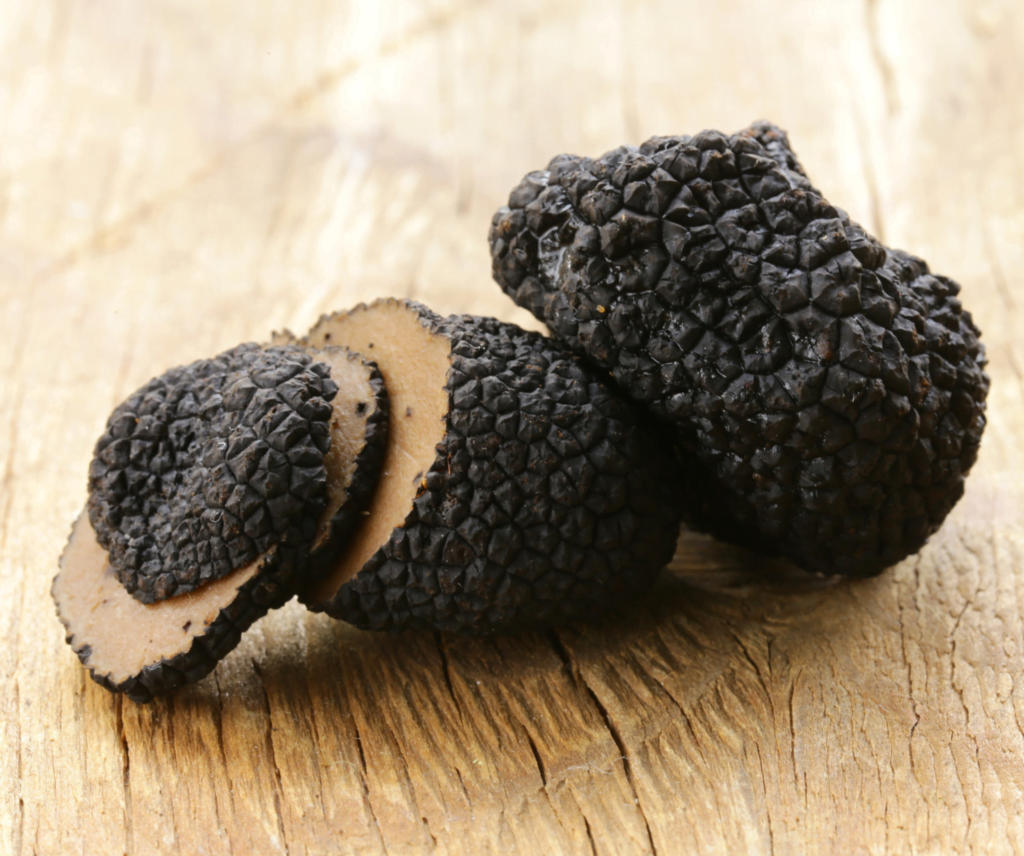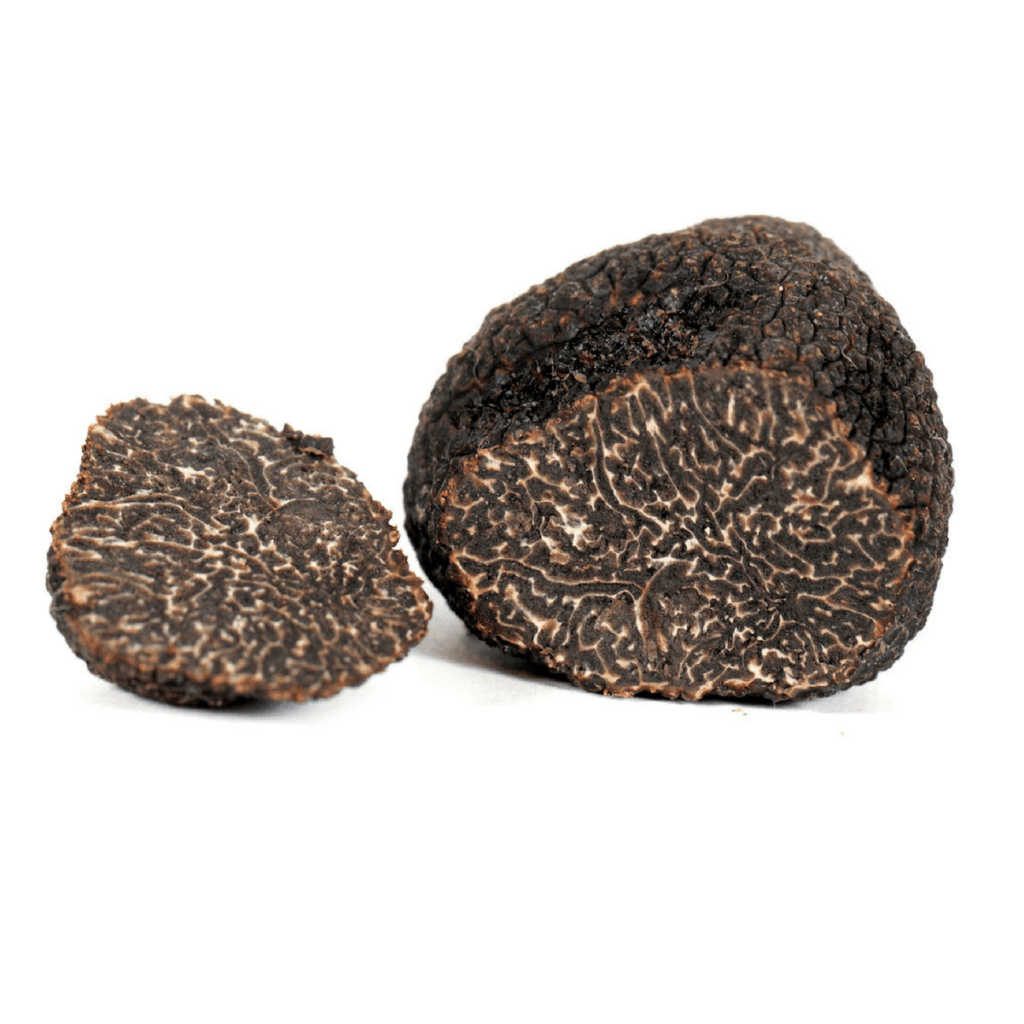Truffles, the “rich cousins” of mushrooms, are a delicacy enjoyed around the world. However, this special fungus, full of fragrance, can be very expensive. I still remember to this day, for example, the report I saw on television in 2014. It talked about the largest white truffle in the world, which weighed almost 2 kilos and had been discovered in Italy. This single truffle was so valuable that it was transported to New York accompanied by security guards and auctioned for $$61,000! At today's exchange rate, this is equivalent to almost R$305 thousand reais. Impressive, isn't it?
But it's not just the white truffle that's worth a fortune, despite being the most expensive of all. There are also several expensive species such as black, white and summer truffles. Below, we can see a photo of a black truffle. What would you do if your child thought it was a brigadeiro? 😂

What are truffles
The truffle is a type of fungus that belongs to the genus Tuber and has a symbiotic relationship with the roots of various trees. This means that truffles survive thanks to the help of the roots of these trees, but in a way in which the trees also benefit. In other words, they are not parasites!
Worldwide, there are at least 40 species of truffles, but don't get excited: many of them are inedible. New species, however, are still being discovered today, including one Brazilian.
The most famous species are white, black and summer truffles, most used in cooking. They occur in some regions of France, Italy and Spain and, as they are underground, they are collected with the help of sniffer dogs.
Due to their price, there are many attempts to imitate the taste or appearance of these traditional truffles. That truffle you see in supermarkets or fancy restaurants may, in fact, not be the traditional truffle, but a cheaper one, with a similar appearance. Truffle oil, for example, often doesn't contain a trace of the real truffle. The cheapest products use 2,4-dithiapentane, a synthesized compound that gives the “earthy” flavor.
The Hunt for the Truffle
Truffles are seasonal and expensive, with a short shelf life. So, you can imagine that when you have your time, it’s a “save yourself if you can”. Everything gets even worse when we think that the truffles are underground, close to the roots, and are not easy to locate. They have to be found and removed manually, in a real race against the clock.
To assist in this activity, humans traditionally used pigs to find black truffles. As incredible as it may seem, pigs are intelligent animals with a great sense of smell. For a long time, they were the standard for harvesting, but while they're great for finding truffles, they're also soooo good for eating them.

For this reason, they have been replaced by sniffer dogs in most companies. These dogs are trained from puppyhood to identify the scent of truffles, similar to police dogs. Their cold resistance and ability to withstand harsh conditions also make them the perfect partners in the search for edible diamonds.
As it is one of the coolest stages of truffle harvesting, we have put together a video for you from an Italian channel about the search for truffles. No need to worry, the video has subtitles in Portuguese!
Chefs' Favorites
The effort dedicated to planting and harvesting truffles results in a variety of recipes, from truffles marinated in oil to truffled eggs, highlighting the leading role of this fungus in cooking. Despite the shared recipes, it is undeniable that each truffle has a distinct aroma and flavor, and, as we have already learned, there are three varieties traditionally used in the kitchen: black, white and summer.
Now, let's explore a little more about the unique flavor of each of these gastronomic gems.
Summer truffle
The Summer Truffle (Tuber Aestivum), also called Black Summer Truffle, is a type of truffle that grows in southern and eastern Europe, from April to August. They have a soft, subtle, less intense aroma and flavor, which makes them cheaper. Its flavor is often compared to that of nuts, cream and honey.
In general, summer truffle has a light flavor that pairs perfectly with seasonal dishes. You can complement it with a drizzle of olive oil and use it on toast as an aperitif, on fish, in a vegetable carpaccio or simply in a salad. It will bring complexity to any dish.

Black Truffle
People compare the taste of black truffles to many things. The flavor is often described as umami – a word that originated in Japan to describe a “fifth type of flavor.”
Its flavor and aroma are also very similar to nuts and mushrooms. Although both mushrooms and truffles are fungi, truffles tend to have a more complex and strong flavor. They please a more sophisticated palate, hence their luxury and the title of delicacy.

White Truffle
White truffle is softer and lighter than black truffle. The flavor and aroma are more subtle, with a flavor similar to garlic, but with notes of pepper. In general, both types of truffles share the same fresh, rich tone, which is reflected differently in each. They also have similar nutty or oak notes.

The Chinese Competitor
For many years, Europe dominated the known truffle market, as traditional black, white and summer truffles only grew in the territories of France, Italy and Spain. However, a lot changed when some Chinese businessmen decided to export truffles from there to other countries instead of feeding them to pigs. These truffles became known as “winter truffles”.
You can imagine that producers in Europe weren't too excited about the news, right? This Chinese truffle, which looks very similar to the black truffle, is constantly accused by them of being inferior, or even a “counterfeit”. One of the main criticisms is that it has less odor and flavor than the traditional one. However, we know that when it comes to a market as rich as this, behind each accusation there are many economic interests.

The Future of Truffles
Faced with the scarcity of natural truffles, intensive cultivation has become a crucial alternative. Today, truffle production through agriculture surpasses wild collection, accounting for 70% of global production. However, the loss of wooded areas and climate change have significantly reduced the number of wild truffles. Since the 19th century, production in France has declined from more than 1,000 tons per season to just 30 tons.
Weather conditions are crucial, not just immediately, but throughout the entire season. With climate change, the threat of truffles disappearing is real. The dependence on rainfall, which makes up around 70% of the truffle content, becomes evident. Some UK scientists predict that within 50 years, traditional truffle areas could lose the industry due to climate change.
References
To write this post, we used several videos and articles in English as reference.
Why Black Truffles Are So Expensive – YouTube
Why Real Truffles Are So Expensive | So Expensive – YouTube
Truffles: The Most Expensive Food in the World – YouTube
What do truffles taste like? | BBC Good Food
Black Truffle: What Does this Gourmet Ingredient Taste Like? (foodlovertour.com)

1 thought on “O Que São as Trufas e Por Que Valem Tanto?”